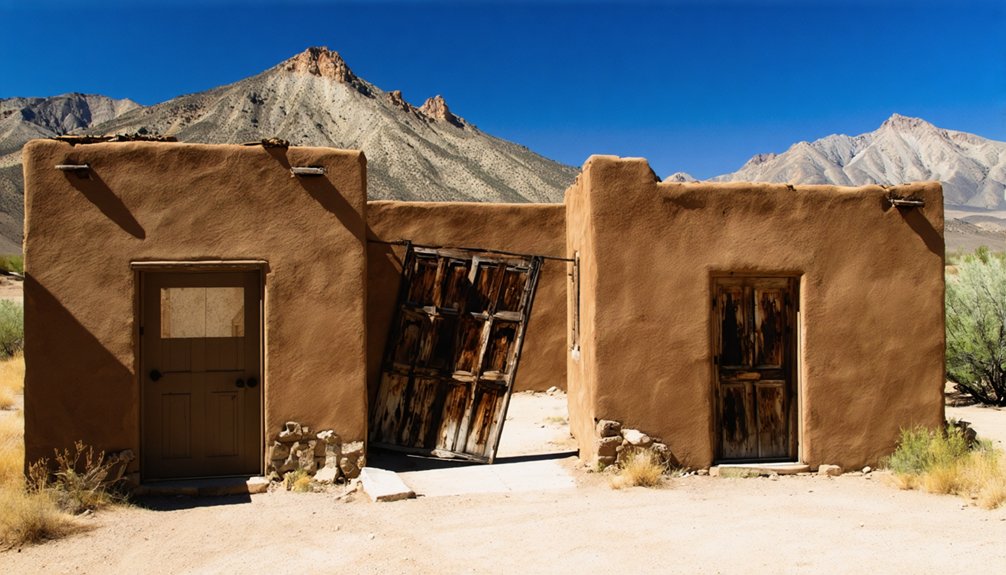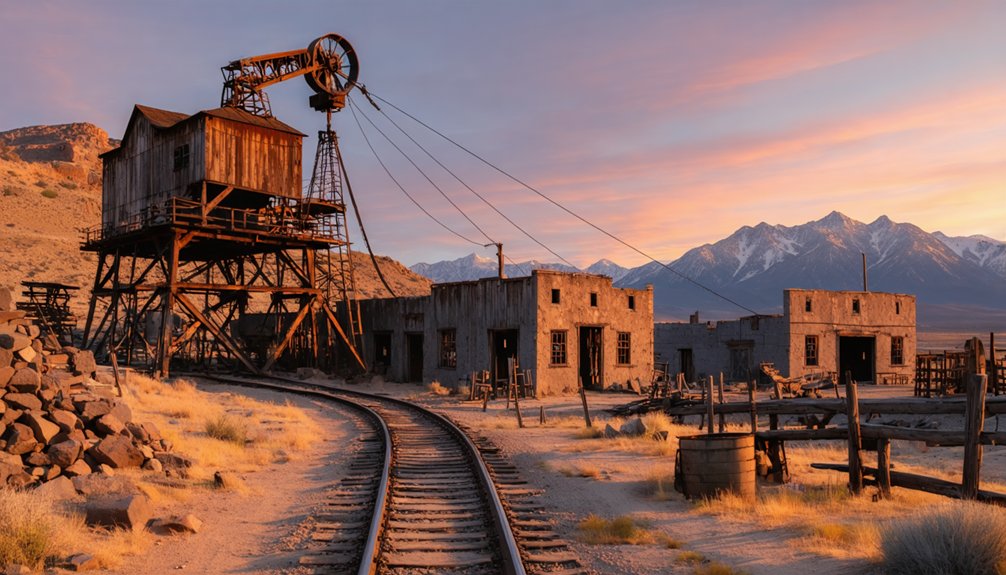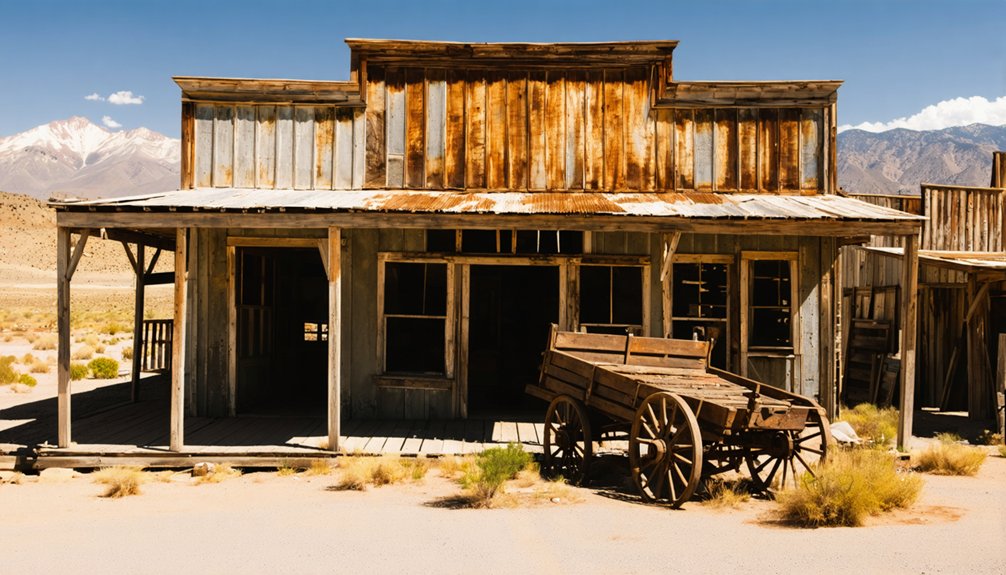You’ll discover Hilltop nestled at 5,702 feet in Arizona’s Chiricahua Mountains, where miners extracted copper, lead and zinc from 1881 to 1973. This well-preserved ghost town showcases abandoned headframes and rusting machinery that tell stories of resilient workers who conquered harsh conditions. During WWII, the area served as training grounds for Buffalo Soldiers from Fort Huachuca. Pack supplies before your visit—no services have existed since 1945. The mountain’s secrets await.
Key Takeaways
- Hilltop emerged as a copper mining settlement in Arizona’s Chiricahua Mountains during the late 1800s, reaching its peak before 1913.
- Located at 5,702 feet elevation, this abandoned mining town is accessible year-round by 2WD vehicles via mountain roads.
- The site features remnants including a deteriorating headframe, abandoned structures, and rusted machinery from its mining heyday.
- Hilltop served as a strategic military training area for Buffalo Soldiers during World War II after its mining operations declined.
- Visitors should bring supplies as no services exist since 1945, and should respect occupied buildings while exploring this ghost town.
The Mining Boom That Built Hilltop (1880s-1913)
As the nation’s industrial appetite for copper grew in the late 19th century, Hilltop emerged from the rugged terrain of Arizona’s Chiricahua Mountains as yet another promise-filled mining settlement.
Perched at 5,702 feet, this Cochise County boomtown capitalized on copper’s rising value during America’s electrification era.
Nestled high in Arizona’s mountains, Hilltop thrived as electricity demand drove copper’s golden age
You’d have witnessed revolutionary mining methods transforming the landscape—shaft sinking, underground tunneling, and mechanical ore processing with stamp mills.
By 1899, rail connections replaced arduous mule-drawn wagons, slashing transport costs to distant smelters.
Companies poured hundreds of thousands into claim development, while innovations like diamond drilling boosted copper production efficiency.
When market prices dipped, operators stockpiled high-grade ore, waiting for favorable conditions to maximize profits from Hilltop’s mineral wealth.
Like many Arizona mining sites, Hilltop became surrounded by tales of lost mines that continued to draw prospectors hoping to discover overlooked riches in the surrounding mountains.
Hilltop’s development occurred relatively late compared to other mining regions, as Arizona remained a territory until 1912 while early booms were already underway in neighboring states.
Life in a Mountain Mining Camp: Daily Existence
While the promise of mineral wealth lured men to Hilltop, daily existence in this mountain mining camp demanded remarkable resilience from everyone who called it home.
You’d find yourself traversing steep terrain while hauling heavy ore loads, constantly watching for desert predators like mountain lions and coyotes.
Community gatherings at boarding houses, often run by miners’ wives, provided vital respite from the labor challenges of extraction work.
Social hierarchies emerged naturally based on expertise and seniority.
Your daily life revolved around:
- Coordinating with family networks who often worked alongside you
- Maintaining essential equipment at communal processing areas
- Preparing ore stockpiles for the long journey to Mojave smelters
- Fortifying structures against the mountain’s harsh conditions
Prospectors carefully examined rock formations for quartz stringers, known to frequently contain gold deposits.
Some miners developed innovative techniques similar to those used at Burro Schmidt Tunnel to avoid difficult terrain when transporting ore.
When not underground, you’d spend evenings in simple cabins clustered together, forming the backbone of this rugged mining community.
Engineering Marvel: The Shaw Peak Tunnel
Beneath the rugged terrain of Shaw Peak, an engineering wonder silently tells the story of human ingenuity against geological odds.
Mankind’s triumph etched in stone—a silent monument to determination beneath Shaw Peak’s formidable mass.
You’ll marvel at how miners conquered this 7,779-foot mountain’s complex geology of granodiorite cores and faulted anticlines.
The tunnel engineering required precise solutions for maneuvering steeply dipping faults and weak, mylonitized rock prone to deformation.
Workers battled tight folding and varying rock strength while creating a passageway that served multiple essential functions: ore extraction, personnel transport, and improved ventilation and drainage.
This remarkable achievement wasn’t just about digging through rock.
Engineers had to stabilize fault zones, reinforce folded sections, and manage water ingress while working at high altitude with seasonal temperature challenges—a demonstration of human determination within the unforgiving Chiricahua Mountains.
Miners tackled an impressive elevation range: 1,561 ft while constructing the tunnel system, requiring specialized engineering solutions for each section.
The area shares similarities with the nearby Phoenix Mountains where hikers now enjoy the rugged terrain once navigated by these hardy engineers.
Economic Rise and Fall of Hilltop Metal Mining Company
The discovery of the Hidden Treasure claim in 1881 sparked what would become a decades-long economic saga in the California Mining District of Arizona.
You can trace Hilltop’s meteoric rise through the 1916 consolidation when fragmented claims merged under one corporate umbrella, revolutionizing the area’s economic impact.
Mining technology evolved rapidly as the company tackled the challenges of extracting diverse minerals:
- Capital infusion funded sophisticated ore processing for lead, copper, zinc, and silver
- Network of shafts—Lead Lily, Dunn, and Blacksmith—accessed increasingly deeper deposits
- Wooden entrance structures and tunnel networks formed the backbone of extraction infrastructure
The operations extended beyond the primary shafts to include additional mining features like the Kasper Tunnel and Rhem Adit, which were part of the extensive mining complex.
The mine reached impressive depths of 457.2 meters through its four major levels of underground workings.
The shift to Queen Mining Company in 1973 marked the final chapter of sustained operations.
The company’s fortunes mirrored the boom-and-bust cycle common to mining towns across the American West.
Traces of the Past: What Remains Today
As the mining companies eventually withdrew from Hilltop, they left behind a scattered legacy now weathered by over a century of Arizona’s harsh desert climate.
You’ll find the skeletal remains of the once-bustling operation—crumbling stone foundations where administrative buildings once stood and rusted machinery partially reclaimed by the desert.
Recent archaeological discoveries have unearthed personal artifacts—miners’ tools, household items, and even preserved documents—providing glimpses into daily life during Hilltop’s heyday.
The deteriorating headframe still stands as a silent sentinel over abandoned mine shafts, now sealed for safety.
Local preservation efforts focus on documenting these fragile remnants before they disappear completely.
Volunteers photograph, map, and catalog remaining structures, racing against time and elements to capture this chapter of Arizona’s mining history.
Similar to Swansea Ghost Town, informational markers throughout the site provide context about the mining history and the remaining structures.
The site represents a stark contrast to nearby cities like Surprise and Kingman, where housing values are currently declining in Arizona’s softening real estate market.
Exploring the Ghost Town: Visitor Information
Visitors seeking an authentic ghost town experience will find Hilltop, Arizona a rewarding destination tucked away in the Chiricahua Mountains at an elevation of 5,702 feet.
This former mining community is accessible year-round by 2WD vehicles, with its mountain climate offering respite from Arizona’s notorious heat.
When exploring this fascinating ghost town attraction, keep these visitor guidelines in mind:
- Bring appropriate gear for the season – mild winters and cooler summers prevail at this elevation
- Respect the few occupied buildings among the mining remnants
- Plan for self-sufficiency as no services have existed since the post office closed in 1945
- Allocate time to examine the 1917 tunnel through Shaw Peak that connected to the new town site
Wartime History: Fort Huachuca’s Secret Training Ground

While hiking through Hilltop’s abandoned structures, you’re actually traversing what once served as a strategic training area for Fort Huachuca soldiers during World War II, when the military leased over 3,000 acres extending to the San Pedro River for artillery practice.
The ghost town’s elevated position and rugged terrain provided ideal conditions for Buffalo Soldiers of the 92nd and 93rd Infantry Divisions to simulate battlefield conditions they’d later encounter in European campaigns.
You’ll notice subtle remnants of this military past—depressions from foxholes and occasional rusty fragments that survived the 1947 munitions removal operations conducted by Detachment No. 14.
Wartime Training Operations
During World War II, Fort Huachuca transformed into one of America’s most significant military training grounds, hidden in Arizona’s southeastern corner. This sprawling 71,253-acre installation became essential to the war effort, housing over 24,400 enlisted soldiers and 1,200 officers engaged in intensive military training.
The Fort’s historical significance is particularly remarkable regarding African-American military history:
- Over 30,000 Black soldiers trained here between 1941-1945
- The 92nd Infantry Division prepared here before deployment to Europe
- The 93rd Infantry Division trained extensively before Pacific Theater operations
- Buffalo Soldiers’ legacy continued as these segregated units served with distinction
When you visit today, you’re walking the same grounds where thousands prepared for combat, standing as a tribute to their contributions during a pivotal time in American history.
Ghost Town Battleground
Hilltop’s crumbling remnants served an essential but little-known wartime purpose as Fort Huachuca transformed this abandoned mining settlement into a specialized combat training ground during World War II.
As you explore the ghostly ruins today, you’re walking through what once buzzed with military adaptations designed to prepare soldiers for European battlefield conditions. The decaying structures of this once-thriving mining town provided the perfect canvas for realistic training simulations, offering tactical complexity that open terrain couldn’t match.
Fort Huachuca, established in 1877 for Apache campaigns, recognized Hilltop’s strategic value in Cochise County. The military ingeniously repurposed these abandoned structures, turning civilian ruins into immersive battlegrounds where troops could experience urban warfare scenarios.
This innovative use of local geography exemplifies the resourcefulness required during wartime preparation.
Military Terrain Advantage
Fort Huachuca’s selection of Hilltop wasn’t merely opportunistic—it represented a masterful assessment of tactical geography that military strategists had recognized since 1877.
When you stand at the base of the Huachuca Mountains, you’ll understand why this location became central to America’s border defense strategy.
The military terrain analysis revealed four critical advantages:
- Elevated vantage points providing surveillance across three directions
- Fresh running water from mountain streams supporting sustained operations
- Natural concealment from abundant trees and sheltering hills
- Proximity to the Mexican border enabling rapid response capabilities
This strategic positioning proved invaluable during the Geronimo campaign of 1886, when General Nelson Miles established his headquarters here.
The same terrain features that protected Buffalo Soldiers later sheltered secret training for specialized WWII units and eventually transformed into today’s electronic warfare proving ground.
Hilltop’s Legacy in Arizona’s Mining Heritage

Though rarely mentioned in mainstream historical accounts, Hilltop stands as a quintessential example of Arizona’s boom-and-bust mining legacy that shaped the territory’s economic and social development.
The town’s underground mining techniques mirrored dozens of similar operations throughout Cochise County, where laborers extracted valuable ore deposits that fueled Arizona’s industrial growth.
You’ll find Hilltop’s story reflected in the cultural diversity of its workforce, where miners from various backgrounds formed tight-knit communities despite harsh conditions.
The settlement’s complete abandonment following resource depletion echoes the fate of countless mining towns across the Southwest.
While no structures remain today, Hilltop’s archaeological footprint serves as a silent reflection to the transient nature of extraction economies that once dominated Arizona’s frontier landscape.
Frequently Asked Questions
Were Any Notable Historical Figures Associated With Hilltop’s Development?
No notable figures stand out in Hilltop’s development. You won’t find famous names linked to its historical landmarks or economic impact—just anonymous prospectors and mining companies that collectively shaped this frontier community.
What Natural Disasters or Significant Weather Events Affected Hilltop?
You’d have faced devastating flood events during monsoon seasons and destructive wildfires impact throughout Hilltop’s history. Drought, severe mountain storms, and temperature extremes further challenged your survival in this isolated mining community.
Did Hilltop Have Schools or Educational Facilities?
You’ll find Hilltop’s educational history centered around a one-room schoolhouse near the mine. It served local children until the 1930s when mining declined and school buildings were abandoned with the town.
What Indigenous Peoples Originally Inhabited the Hilltop Area?
Like threads woven through time, your area’s Native tribes included the Hualapai, Havasupai, Yavapai, and Apache peoples, each contributing to the rich cultural heritage that predated Hilltop’s mining era.
Were There Any Significant Crimes or Lawlessness in Hilltop?
You won’t find significant crime rates in Hilltop’s history. Historical records show no notable lawlessness, with the settlement remaining peaceful despite minimal law enforcement presence throughout its existence.
References
- https://www.wikiwand.com/en/articles/Hilltop
- https://www.travelbackland.com/post/jerome-arizona-spend-a-day-in-america-s-largest-ghost-town
- https://www.therockerbox.com/cochise_county_az_ghost_towns.htm
- https://www.arizonahighways.com/ghost-town-trail
- https://www.ghosttowns.com/states/az/hilltop.html
- https://www.sedona.net/jerome
- https://www.azghosttowns.com/towns/hilltop.html
- https://kids.kiddle.co/Hilltop
- https://data.azgs.arizona.edu/api/v1/collections/AGCR-1552428433242-632/cr-17-a_ajo_final.pdf
- https://www.nps.gov/para/learn/historyculture/copper-from-discovery-to-boom-to-ruin.htm



